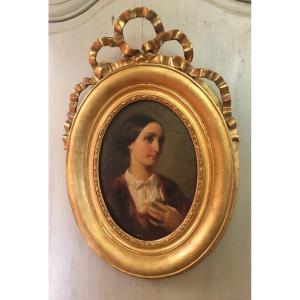Portrait of the artist's mother in the studio, 1895
Oil on canvas
34.5 x 22.5 cm
46 x 34 cm with its frame
Signed and dated lower right
Son of a clothier from Lodève, Eugène Lagare attended school in Montpellier, where he showed a real aptitude for drawing very early on. At eighteen, he left to study for his baccalaureate in Paris, where he met the painter Pierre Auguste Cot, a family friend from Bédarieux. At the same time, he worked in the studio of the painter Diogene Maillart, bonding with his son Roger, also a painter. In 1892, upon the death of his father, Eugène Lagare gave up taking over the family sheet factory and remained in Paris to devote himself to painting. He joined Gustave Moreau's workshop at the École des Beaux-arts, where he rubbed shoulders with Matisse and Rouault, before gradually moving towards sculpture. He is forced to carry out decorative work to meet his needs and to support his mother, who has come to join him. Around 1898, following his meeting with Auguste Rodin, he devoted himself definitively to sculpture and chose to enter the latter's workshop, first as a student, then as a practitioner. From 1900, he exhibited his works at the Salon de la Société nationale des beaux-arts, where in 1913 he became a member of the jury of the sculpture section. Under the patronage of Rodin, he joined the New Society of Painters and Sculptors, before participating in 1904 in the Indépendants, as well as in the exhibition of the band in Schnegg at the Barbazanges gallery. Also defended by the dealer Georges Petit, he was present in March 1907 at the exhibition of contemporary French art in Strasbourg (then attached to the German Empire), in 1908 at the Franco-British Exhibition in London, in 1911 at the Royal Scottish Academy Exhibition in Edinburgh, and in 1913 at the Universal Exhibition in Ghent in Belgium. At the outbreak of war, Eugène Lagare was unable to mobilize due to health problems; he left Paris to join his family in the South. He was interned in the Font d'Aurelle psychiatric hospital in Montpellier, where he died in 1929. Dated 1895, the small oil on canvas that we are presenting constitutes a rare testimony to Lagare's painted production at the time when he is a student of Gustave Moreau. The young artist depicts a frontal and psychological portrait of his mother, seated, frozen like a Flemish primitive, wearing the black of her widowhood. If Moreau's technical influence does not seem significant, his lesson is suggested by the presence of small sketches hanging on the walls of the workshop. We can indeed distinguish haloed characters in rock decorations, which can undoubtedly be linked to the traditional, often biblical, subjects of the École des Beaux-arts competitions. As if to accentuate the eclecticism of the decor, Lagare adds to the desk the colorful motif of a Chinese vase in blue and white porcelain, arranged upside down, on the collar. As paradoxical as it may seem, this composition clearly evokes the very liberal and innovative teaching provided by Moreau, who in 1896 aroused the praise of Roger Marx: “In the middle of the École des Beaux-Arts, a source of revolt was kindled: all the rebels against routine, all those who intend to develop according to the sense of their individuality have grouped themselves under the aegis of Gustave Moreau[1].” By combining a certain connection with the ancients with a fairly direct and fine observation of nature, our canvas is closer to the contemporary works of Charles Milcendeau or Henri Evenepoel, other students of the master.
[1] Marx, R., “Le Salon du Champ-de-Mars”, Revue encyclopédique, April 25, 1896, p. 280.


































 Le Magazine de PROANTIC
Le Magazine de PROANTIC TRÉSORS Magazine
TRÉSORS Magazine Rivista Artiquariato
Rivista Artiquariato